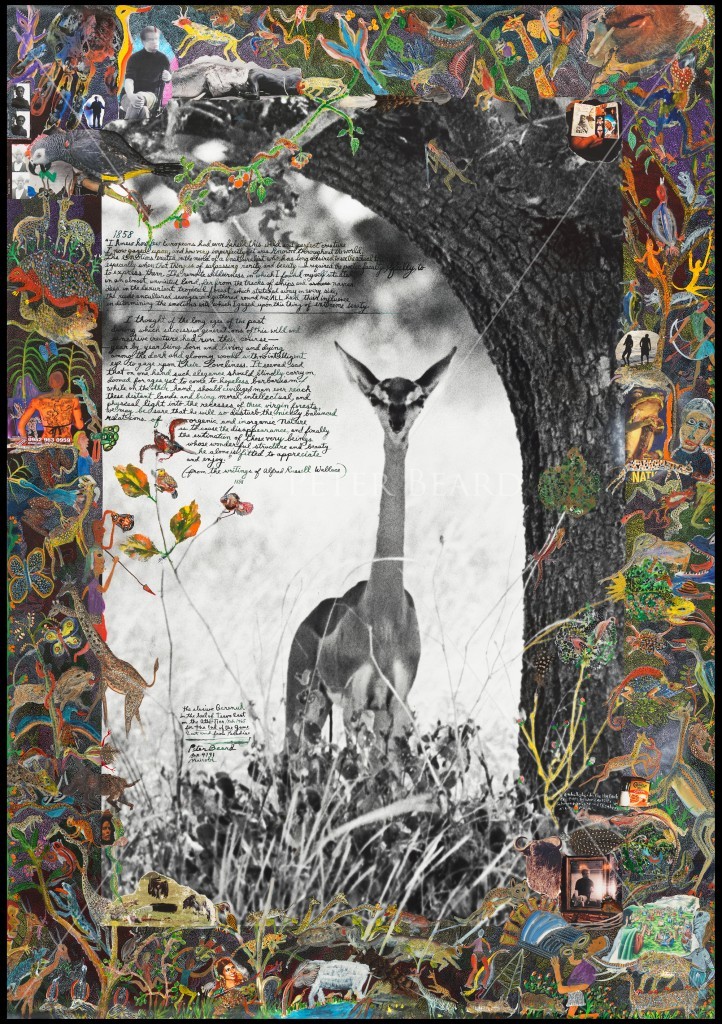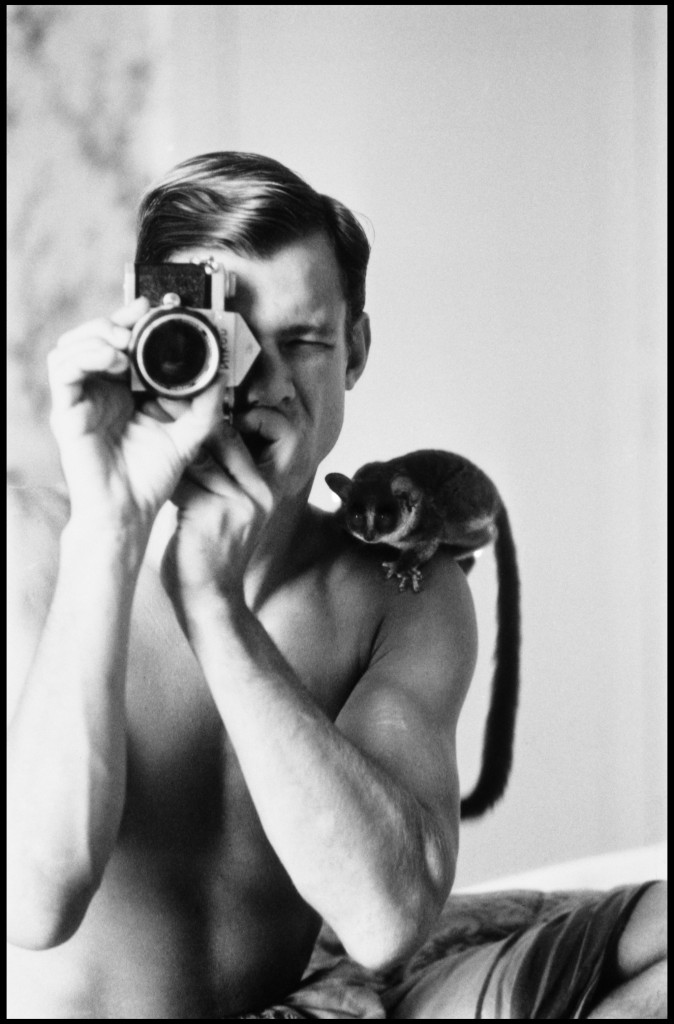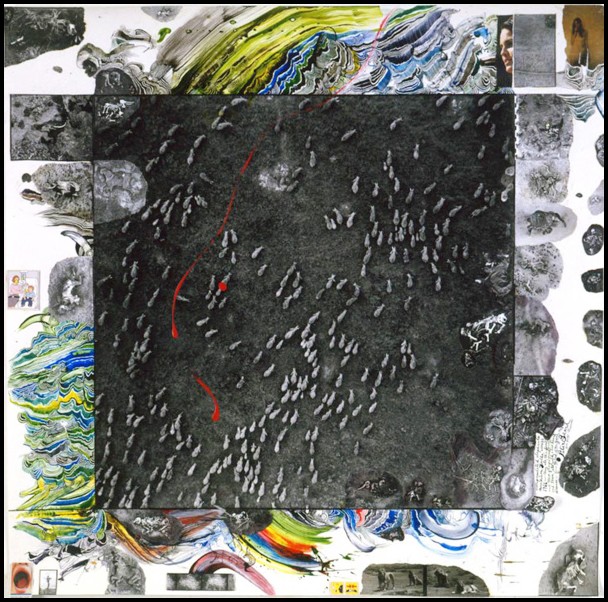Some time ago, an elderly man with dementia wandered out of his house in Montauk, Long Island. After a three-week search, he was found dead in the woods, a fitting end for someone who loved nature as he did. The man was Peter Beard, 82, photographer and artist by profession, adventurer and playboy by nature.

In 1996, I came by chance upon his exhibition Carnets Africains, at the Centre National de la Photographie, in Paris. His works entranced me: huge photos of wildlife, in black and white, embellished all around with smaller pictures, ink drawings, diary and sketchbook pages, magazine cuttings, dried leaves, ticket stubs. Sometimes he’d drawn or scribbled over the central picture itself, with red or black ink, or colors. Each work was a whole, sometimes heart-rending, world into which you entered and wandered about. The artist himself was there in the gallery, walking around with a cane, since he was recovering from having been trampled by an elephant.
Born into wealth and privilege in New York, Peter Beard was possessed of an artist’s eye and a love of animals from a young age. He found fame as a photographer of African wildlife and of beautiful women, and also as a diarist and collagist of rare insight.
As a young man, Beard fell in love with Kenya where he’d travelled after being inspired by the book ‘Out of Africa’. He eventually bought a property named Hog Ranch, next to the estate of its author, Karen Blixen (pen name Isak Dinesen). He photographed the plight of elephants and other wildlife at Tsavo National Park, eventually producing a book called The End of the Game. In the second edition, he documented a massive population die-off in Tsavo of 35,000 elephants and 5,000 rhinos as the animals succumbed to starvation, stress and density related diseases.
His main area of focus, and great cause of sadness, was mankind’s negative impact on the natural world. In his own words: “The beautiful play period has come to an end. Millions of years of evolutionary processes have been destroyed in the blink of an eye.”

Beard spent decades photographing Africa and its creatures, but he was a man of extremes: swimming in croc-infested waters one day, painted by Francis Bacon the next. Because he was also a bon vivant, party animal, and lover of beautiful women, befriending and photographing a wide range of celebrities and icons. He became well known for his hedonistic and flamboyant playboy lifestyle. Bob Colacello of Vanity Fair famously described him as: “half Tarzan, half Byron.”
For twenty years, from the mid-60s to the mid-80s, Peter Beard was the Golden Child of New York. He knew everyone and was friends with the likes of Jackie Kennedy, Francis Bacon, Mick Jagger, Truman Capote and Andy Warhol. He partied with models at Studio 54, and partook of any recreational substance available. However, he was liked and respected by all, because he was good-hearted and never put on airs.

Beard was married three times, first to socialite heiress Minnie Cushing, then briefly to model Cheryl Tiegs, and thirdly to Afgan-born Nedjma, who survives him with their daughter, Zara.
His charmed life, however, suffered some serious reversals: he barely survived the encounter with the elephant, which left him with some serious injuries. Also in 1977 his house in Montauk burned to the ground, and with it it thousands of photos, a processing lab, a 20-year scrapbook diary, and more. Despite the huge financial loss, what hurt him most was the loss of the irreplaceable scrapbooks.

By the 1970s, Beard had created a unique series of artworks by combining photographs, text from his daily journals and various found objects such as dried leaves, insects and newspaper cuttings, and sometimes animal blood, or even his own. This body of work is his legacy: a far-sighted and deep commitment to the cause of reversing, or at least halting, an African ecological catastrophe.
In the course of a Vanity Fair interview, he once declared: “We’re in deep shit.” And indeed, unfortunately he’s being proved right.



The scrapbook diary sounds fascinating
LikeLiked by 1 person
Yes, I saw some of his scrapbooks at that exhibition and they were stunning! So creative and multi-layered.
LikeLiked by 1 person
Fab!
LikeLiked by 1 person
Lovely story. Thank you. I would have liked to have known him.
LikeLiked by 1 person
He must have been a fascinating man, I’m sure.
LikeLike
Fabulous post. I hadn’t heard of him before. Amazing work and a fascinating person. I can image how devastated he must have been over the loss of his scrapbooks.
LikeLike
Yes, can you imagine, all this work. Priceless and irreplaceable
LikeLike
Thank you for this story about a man who did so much to care for the endangered planet, especially its rare and glorious animals.
I’ve been around only sporadically but wanted to tell you how much I enjoy your art. You’ve found a voice and a vision in your art.
LikeLike
Thank you, Sharon, you’re always so encouraging 🌹😘
LikeLike
Very much a prophet, someone who could see it all coming. It must have broken his heart to discover he had been right.
Fine tribute, Marina.
Best wishes, Pete.
LikeLike
I’m glad you enjoyed it, Pete. I love animals, and I love art, so I found his works stunning.
LikeLiked by 1 person
That fire must have been absolutely devastating! Thank you for this.
LikeLiked by 1 person
Yes, can you imagine losing so much work…
LikeLiked by 1 person
I don’t want to!!
LikeLiked by 1 person
One of the most beautiful and inspiring posts I’ve come across in a long time. I did read about him disappearing, but wasn’t familiar with his work – though I just might have met him in NY in the late 60s. . The works you’ve chosen are incredibly original … many thanks!
LikeLiked by 1 person
Glad you enjoyed it, Bea. It was difficult choosing. He was very prolific, and I love most of his stuff.
LikeLiked by 1 person
Fascinating and far-seeing
LikeLiked by 1 person
Yes! Thanks, Derrick..
LikeLiked by 1 person
Great post. What a fascinating man he must have been.
LikeLiked by 1 person
I have just come across your post. As you know, I have become enamoured with collage over the last few weeks, so I am fascinated by his work. Some great ideas to use as a springboard.
LikeLike
Yes! I love collage too. Have you tried eco-printing? That’s super fun, and I use the pages for collage too. Or I draw moths and insects on them…
LikeLike
What an amazing life! I had no knowledge of this man. Thanks for correcting that.
LikeLiked by 1 person